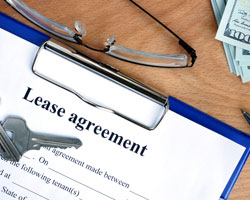Understanding Real Estate Lease Agreements
How Is A Real Estate Lease Agreement Formed? What Rights and Responsibilities Are Commonly Part of a Lease Agreement?
 When you’re looking for property, whether as a residence or a place to conduct business, there can be many advantages to leasing, rather than buying. You’ll generally have more flexibility, as you’ll be able to walk away from the property more easily, and won’t have to come up with a substantial amount of money as a down payment. You may also be able to get your landlord to make most or all required repairs to the premises.
When you’re looking for property, whether as a residence or a place to conduct business, there can be many advantages to leasing, rather than buying. You’ll generally have more flexibility, as you’ll be able to walk away from the property more easily, and won’t have to come up with a substantial amount of money as a down payment. You may also be able to get your landlord to make most or all required repairs to the premises.
Landlord-Tenant Law—An Overview
In virtually every state, the laws governing the relationship between the landlord (property owner) and the tenant (person with physical possession/occupancy) are a blend of statutes and judge-made decisions (also known as “common law”). In 1972, a model code governing landlord-tenant relationships—the Uniform Residential Landlord Tenant Act—was proposed. Twenty states have since adopted some or all of its provisions.
Most of the rights and obligations of landlords and tenants are contractual, typically contained in a written lease agreement. As a general rule, while state statutes may mandate certain provisions in a lease agreement, the parties have a significant amount of discretion regarding the specific terms.
What Is a Lease Agreement?
A lease agreement is a contract, typically in writing, which establishes the rights and responsibilities of all parties involved in a real property rental transaction. The document sets forth the terms of the relationship between the landlord (“lessor”) and tenant (“lessee”), customarily identifying the duration of the agreement, any monetary compensation that will pass between the parties, any limits on the use of the property, and the remedies if one or both parties fail to honor their promises.
How Is a Lease Agreement Formed?
Under the laws of virtually every state, contracts for the lease of real property must be in writing. A lease agreement is formed when the parties sign a written document (the “lease”). To be valid, the lease must describe the property being rented, the length (or “term”) of the agreement, and the amount that will be paid by the lessee for the use of the land.
What Are the Key Terms in a Lease Agreement?
Though the parties to a real property lease have substantial latitude with respect to the language of the agreement, the following terms should always be included:
- The names of the landlord and all tenants
- The length of time the lease agreement will be in force
- The agreed-upon rent (monetary or other compensation) the tenant will pay for the use of the property
- Any limitations on the tenant’s right to use the property
- Whether a security deposit is required (including how much, as well as the circumstances under which the landlord may use the deposit to cover unpaid rents, damages, or other expenses)
- Who has responsibility for making repairs
- The circumstances under which the landlord may enter the premises
- Whether pets are allowed, including the circumstances (extra deposit, increased rent) under which that is permissible
What Are the Different Types of Leases?
There are different types of property leases, based on the types of property expenses covered by the rent payment:
- The “gross” lease—In this situation, the rent paid by the tenant covers the cost of all property operating expenses, such as utilities, maintenance, and property taxes.
- The “net” lease—With a net lease, the tenant pays a smaller monthly rental amount but is personally responsible for most other expenses, including utilities.
- The “modified gross lease”—A compromise for landlords and tenants, this type of lease agreement usually has a fixed monthly rental charge that includes some of the cost of property operations.
The Legal Duties of Landlords and Tenants
Though the details of the law vary from state to state, there are certain obligations of landlords and tenants that are more or less universal.
- The duties of landlords—Though the language may be a little different, virtually every state has some type of written law that requires the following of landlords:
- Certain standards of “habitability”—Landlords must provide premises that are:
- Structurally safe and intact;
- Free from pests, such as rats or bugs; and
- Free from environmental hazards, such as toxins or insect infestations.
- Reasonable steps to ensure the “quiet enjoyment” of the premises—Landlords must take reasonable measures to address or alleviate activities by other tenants that limit the “quiet enjoyment” of the leased property.
- Reasonable safety measures—Landlords must provide appropriate safety equipment (such as smoke alarms and fire extinguishers), maintain proper security, and screen potential tenants to promote the safety of all tenants.
- Make reasonable repairs
- Monitor the condition of the premises and take measures to address “wear and tear”
- Certain standards of “habitability”—Landlords must provide premises that are:
- The duties of tenants—The language of a lease typically includes provisions requiring that the tenant:
- Take appropriate steps to prevent any damage beyond reasonable wear and tear—The tenant generally agrees to use best efforts to minimize unnecessary damage to the leased property.
- Keep the premises reasonably clean—The tenant has a duty to promote good sanitation in the leasehold, disposing of trash in a timely manner and taking reasonable steps to prevent buildup of dirt, scum, grime, or similar factors.
- Notify the landlord of problems—The tenant must provide timely notice to the landlord of any repairs that need to be made or any other issues that may negatively affect the fair market value of the leased property.
The Remedies Available to Landlords and Tenants
Because the relationship between a landlord and a tenant is contractual, if one of the parties to the agreement fails to perform or otherwise breaches the agreement, the other party may look to either the terms of the agreement or any remedies provided under state law.
Remedies Available to the Landlord–Though those remedies can vary from jurisdiction to jurisdiction, among the common remedies available to a landlord when a tenant breaches a lease agreement are:
- Termination of the lease agreement—The landlord typically has the right to declare the lease agreement terminated, thereby allowing for the recovery of the property.
- Eviction of the tenant—If a breaching tenant refuses to leave voluntarily, the landlord has the right to file the appropriate documents to enlist the aid of the court in removing the tenant from the premises. Self-help as a method of eviction is generally restricted. Some states do not even allow it for tenants who hold over after the end of a lease. Landlords are also restricted from evicting tenants in retaliation after the tenant takes action to enforce a provision of the lease or applicable law.
- A civil lawsuit for damages—The landlord may bring a breach of contract action, seeking compensation to cover any losses sustained because of the wrongful conduct of the tenant, including lost rents.
- A landlord’s lien—Some jurisdictions allow a landlord to obtain a lien on the personal property of the tenant in order to secure the remittance of any unpaid rent.
- Use of the tenant’s security deposit—The lease agreement commonly identifies the extent to which the security deposit can be used to cover lost rents; under some leases, a security deposit can only be applied to property damage or loss.
Remedies Available to the Tenant—As a general rule, tenants have fewer legal options when the landlord breaches the agreement:
- Constructive eviction—Where the actions of the landlord either make the premises uninhabitable, or otherwise unreasonably interfere with the tenant’s rights of use and possession, the tenant may argue that the lease is effectively terminated. The tenant may then vacate the premises and refuse to pay any further rent.
- A right to cure—A tenant who wants to remain on the premises may choose not to abide by the terms of the lease until the landlord remedies a situation that is contrary to the terms of the lease agreement.
- Damages or other remedies for breach of contract—The tenant may file a civil lawsuit, seeking compensation for the loss of the bargain made with the landlord when the lease agreement was entered. A tenant can ask the court to essentially rewrite the terms of the lease agreement if it can be demonstrated in court that the original lease was based on a mistake or fraudulent act of the landlord. The tenant may also ask the court to void the lease.
What Is a “Rent-to-Own” Lease Agreement?
A rent-to-own lease agreement is one where, under the terms of the contract, the monthly rent payments may be converted to mortgage or land contract payments, allowing the tenant/lessee to purchase the home. In many such instances, the tenant pays rent at a rate higher than market value, with the additional amount being allocated toward a down payment on the purchase of the house.
What Is the Difference between a Lease Agreement and a Rental Agreement?
As a practical matter, in most states, the terms “lease” and “rental” are interchangeable. Some jurisdictions make a distinction between the two:
- Lease agreements—Where the two terms are not used to describe the same legal relationship, a lease agreement is one that offers a specific term, or length, usually at least 6 months and often a minimum of a year.
- Rental agreements—Some jurisdictions use this term to describe real estate rental agreements that are month-to-month, or that don’t have any stated length/term. These types of agreements generally renew automatically by operation of law at the end of each month, unless one of the parties terminates the agreement.
A rental agreement (or month-to-month lease) can be desirable when you need short-term housing, as you don’t have to sign a long-term lease. However, with a rental agreement (or month-to-month lease), your landlord has more flexibility in the price charged. A lease can lock in monthly rents for a year, whereas you may experience dramatic increases in your monthly cost under a month-to-month agreement
Summary
If you’re looking to use property, but you can’t or don’t want to buy, a lease agreement establishes and protects your rights. The terms of a lease are contractual, established by the parties.
Connect with Top-rated Attorneys Near You
Sponsored Advertisement
Other Real Estate Law Topics
Loan Documents and Mortgages
Loan Questions
Oil, Gas, and Mineral Rights in Real Estate Transactions
Real Estate Closing
An Overview of Real Estate Contracts
Real Estate Law Resources
Subprime/Nonprime Mortgages—An Overview
The Function and Value of Title Insurance
Transfer of Ownership
Water Law
Zoning and Land Use
Understanding Construction Contracts
Latest Article
What Is Adverse Possession?
How Does Adverse Possession Affect Property Ownership? One way that property owners exercise their property rights is b... Read More
Deficiency Judgment and Foreclosures
A person borrowing money to buy a home assumes the loan is secured by the mortgage lien on the house. In the event the h... Read More
How Can a Lawyer Help You Defend Against Foreclosure?
If you fall behind on your mortgage payments, your house might end up in foreclosure. However, there can be good defense... Read More
GETLEGAL®ATTORNEY DIRECTORY
Find Leading Attorneys in Your Area
NEED PROFESSIONAL HELP?
Talk to an Attorney
How It Works
- Briefly tell us about your case
- Provide your contact information
- Choose attorneys to contact you





